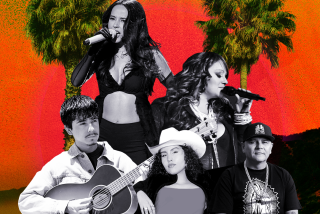More Than Just Sport or Spectacle, Mexican Rodeo Is a Tradition
- Share via
The charro , fancily clad in an outfit that included chaps and sombrero, looked worried as he sat atop the bullpen before the charreada (rodeo).
“They’re telling me it’s my turn to ride him,” Heraclio Guitron said, referring to Diablo, a gray Brahman bull not known for a playful disposition.
Nearby, more than 4,000 people were settling into the grandstand of the Pico Rivera Sports Arena.
Although his dark eyes revealed no rage, it was clear that Diablo, as he jostled his pen mates in the morning sun, was well-named. Guitron would be in for a devil of a time attempting to ride the horned, 2,000-pound beast.
Guitron, 24, drives trucks for a living, but his love for horses has made him a rodeo devotee since he was 7.
“When you come from Mexican parents, it’s the way you’re brought up,” he said. “It’s a family thing, a tradition. If you like it, you stick with it.”
The charreada , the nostalgic national sport of Mexico, involves an exhibition of several rodeo events by charros (cowboys), who perform without pay, and musical entertainment.
In the crowd on a recent Sunday were people of all ages. Little girls in party dresses held the hands of their fathers wearing bandannas and hats. The atmosphere, festive with Mickey Mouse balloons, tamales, beer and cotton candy, became nostalgic when a band played a song about the north-central Mexican state of Zacatecas.
Charreadas, which have long been held in the Los Angeles area, originated centuries ago in Mexico as a test of riding and roping skills.
“This is our hobby,” explained Sergio Duran, the public address announcer who is a disc jockey on KWKW radio. “We enjoy it as much as (Americans) enjoy a Dodger game or a Raider game. This is what really identifies Mexico.”
It is an expensive hobby for the charros , said Duran, 40, a charro himself. “You have to feed your horse and have a place to keep him,” he said.
Pointing to his huge sombrero, he went on: “And something like this, you pay $350. That’s not cheap. And this belt is hand-sewn, very expensive, $300 to $400. Every charro has one. You have to look good. You have to have at least three or four charro outfits. And a saddle . . . that’s another thing.”
On one Sunday last summer, there was another attraction at the charreada-- singer Linda Ronstadt. She entered the arena on horseback and dressed in a white dress and sombrero.
Ronstadt delighted the crowd with Mexican songs from her album, “Canciones de mi Padre” (“Songs of My Father”). On the record jacket to that album, Ronstadt had stated that singing and riding in a charreada was “a cherished dream of mine.”
From her smile--and the smiles all around the arena--it was a dream fulfilled.
More to Read
Sign up for Essential California
The most important California stories and recommendations in your inbox every morning.
You may occasionally receive promotional content from the Los Angeles Times.










